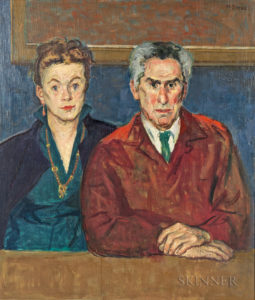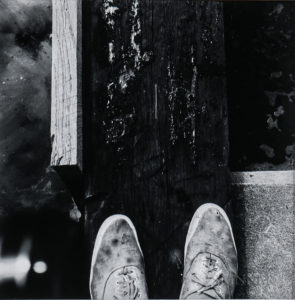The January 26th auction of American & European Works of Art at Skinner features some delightful and surprising takes on portraits of artists.

Moses Soyer (American, 1899-1974) Portrait of Chaim and Renee Gross
Traditionally, through fine prints, photographs, sketches, and oils, artists have captured likenesses of their circles, their friends, students, and mentors. Some may not resonate immediately as portraits of artists, appealing as sensitive portrayals of individual characters without any clues to their professions. Such is the case with William Merritt Chase’s portrait of artist Lilian Westcott Hale (Lot 330) a work traditionally known as Lady in Black. Chase kept this portrait in his collection, and it descended from his estate. The same sort of provenance is true for Moses Soyer’s portrait of Chaim and Renee Gross (Lot 350). Chaim Gross was a good friend of the Soyer family, including artists Isaac and twin brothers Moses and Raphael. Moses Soyer’s depiction of Chaim Gross and his wife Renee is a strongly colored, forthright portrait with a particular emphasis on the sitters’ expressions and Chaim’s folded hands. Soyer kept the painting, and it was eventually given to the St. Louis Art Museum by the artist’s estate.

George Bellows (American, 1882-1925) Elsie, Emma and Marjorie, Second Stone, 1921
Another charming example comes from George Bellows (Lot 19), a group portrait of Elsie Speicher, Emma Bellows, and Marjorie Henri. Bellows regularly socialized with fellow artists Eugene Speicher and Robert Henri, thereby bringing their wives together. The ladies are posed congenially on a chair and sofa, both of which appear regularly in Bellows’s compositions. The three artists are seen in the shadowed background as a tight-knit group, deep in conversation: Bellows with his back to us, Speicher in the middle facing us, and Henri in profile to the left.
Other portraits are composed to include objects or settings that reflect the artist’s persona. Painter Louis Kronberg is portrayed by his student, A.C. Goodwin, in an affectionate portrait of the artist at work at his easel. We look over the shoulder of Kronberg, who is painting a ballerina, one of his most beloved subjects, with the model in a tutu posing to the right. (Lot 341) Another stunning example is George Daniell’s photographic portrait of Georgia O’Keeffe with Skulls (Lot 107). The subject of the current exhibition at the Peabody Essex Museum in Salem, curated by Wanda M. Corn, Georgia O’Keeffe carefully shaped her public persona to support her independent, modernist aesthetic. Here Daniell shows the artist in her signature clothing by a row of animal skulls, images of the southwest that inspired so many of her paintings. In a more spare characterization, photographer Berenice Abbott presents Edward Hopper in a three-piece suit, seated near a pot-bellied stove in his New York studio, his hat hung jauntily on the spoke wheel of his etching press jutting into the composition on the right (Lot 99).
A new take on what might be called a self-portrait is by Les Levine, Les Levine’s Greatest Hits: “Dream” Dinah Washington, Yellow Ochre (Lot 402). For this whimsical, mixed media piece, the artist applied pigment to the soles of his feet and danced across a large sheet of paper to Dinah Washington’s song “Dream.” Across the middle of the composition, Levine applied a series of photographs that were taken by an automatic camera that recorded the activity. It is a multi-media portrait capturing the spirit of the artist and the song, as well as his footprints.

Robert Rauschenberg (American, 1925-2008) Photographs/A Portfolio of Twelve Works, 1949-61
And then there is the portrait where the object stands in for the person. Such is the case with Sneakers, 1950, by Robert Rauschenberg, part of Photographs/A Portfolio of Twelve Works published by Sonnabend Editions, New York, 1980. (Lot 139). Rauschenberg has said, “I like the experience that says that a shirt changes when it gets in the sun a little, or when you go swimming in it, or when the dog sleeps on it…I like the history of objects. I like humanitarian reportage.” In this case, the well-worn sneakers speak to the experiences and history of their owner. In another twist, the cover of the portfolio box includes a portrait photograph of Rauschenberg, taken by Cy Twombly, one of the artist’s closest friends.
